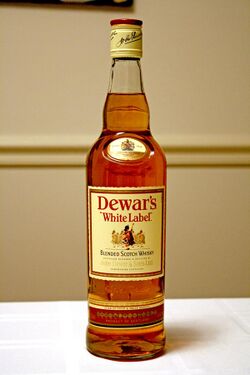Fifth (unit)
A fifth is a unit of volume formerly used for wine and distilled beverages in the United States, equal to one fifth of a US liquid gallon, or 25 3⁄5 U.S. fluid ounces (757 milliliters); it has been superseded by the metric bottle size of 750 ml,[1] sometimes called a metric fifth, which is the standard capacity of wine bottles worldwide and is approximately 1% smaller.
History
Before the mid-19th century, the capacity of British alcohol bottles used for wine and distilled liquors was nominally a quart, but the actual capacity varied considerably. Four primary styles existed, with different average capacities: 759 ± 27 ml (715–810 range); 781 ± 47 ml (724–880); 808 ± 49 ml (739–835); and approximately 1130 ml, the "imperial wine quart". Beer and cider bottles had a different range of sizes.[2] In 1842, it was reported that ordinary wine bottles were 1/6 of an imperial gallon, that is, 758 ml.[3]
In the late 19th century, liquor in the US was often sold in bottles which appeared to hold one US quart (32 US fl oz; 950 ml), but in fact contained less than a quart and were called "fifths" [4] or commercial quarts.[5]
At this time, one-fifth of a gallon was a common legal threshold for the difference between selling by the drink and selling by the bottle or at wholesale,[5][6][7] and thus the difference between a drinking saloon or barroom and a dry-goods store.
The fifth was the usual size of bottle for distilled beverages in the United States until 1980.[8] Other authorized units based on the fifth included 4⁄5 pint, called a tenth, and 1⁄10 pint.[9]
During the 1970s, there was a push for metrication of U.S. government standards. In 1975, the Bureau of Alcohol, Tobacco and Firearms, in cooperation with the Distilled Spirits Council of the United States, proposed metric-standard bottle sizes to take effect in January 1979 and these standards were incorporated into Title 27 of the Code of Federal Regulations.[9][10] These new sizes were 50 ml (a miniature), 100 ml, 200 ml, 375 ml (355 ml for cans), 500 ml (discontinued for distilled beverages in June 1989, but not for wine),[11] 750 ml (the usual size of a wine bottle), 1 liter, and 1.75 liter (a metric half-gallon or handle). Wine also has a standard 187 ml (6.6 imp fl oz; 6.3 US fl oz) measure and uses 1.5 liters (a magnum) instead of 1.75.
See also
References
- ↑ E. Frank Henriques, The Signet Encyclopedia of Wine, p. 298
- ↑ Olive R. Jones, Cylindrical English Wine and Beer Bottles 1735–1850, Studies in Archaeology and History, Environment Canada, 1986 full text, Appendix B, Tables 20–23
- ↑ Jones, p. 109
- ↑ United States Congress, "Report of hearings on H.R. 16925 to Regulate the Storage of Food Products in the District of Columbia", January 24, 1910, p. 300
- ↑ Jump up to: 5.0 5.1 Municipal League of Los Angeles, Municipal Affairs 2:1 (January 1907) "commercial+quart" p. 4
- ↑ The Southwestern Reporter 55, 1900, p. 212
- ↑ Annual report of the Board of State Viticultural Commissioners (California), 1894, p. 71
- ↑ testimony of Carl L. Alsberg, "Amendments to the Pure Food and Drugs Act", Commonwealth of Virginia, 1919, p. 17: "The ordinary whisky bottle contains one-fifth of a gallon, or 253⁄5 ounces [...] They are either marked 25 ounces, or one-fifth of a gallon."
- ↑ Jump up to: 9.0 9.1 27 CFR Chapter I, Part 5, Subpart E, Section 5.47a Metric standards of fill for distilled spirits bottled after December 31, 1979
- ↑ "Old Standard Fifth Due New Moniker", Indiana Evening Gazette, 16 July 1975, p. 40
- ↑ "Packaging regulations for alcoholic beverages". Colorado State University. Archived from the original on 12 March 2015. https://archive.today/20150312071341/http://lamar.colostate.edu/~hillger/laws/alcohol.html. Retrieved 12 March 2015.
 |


